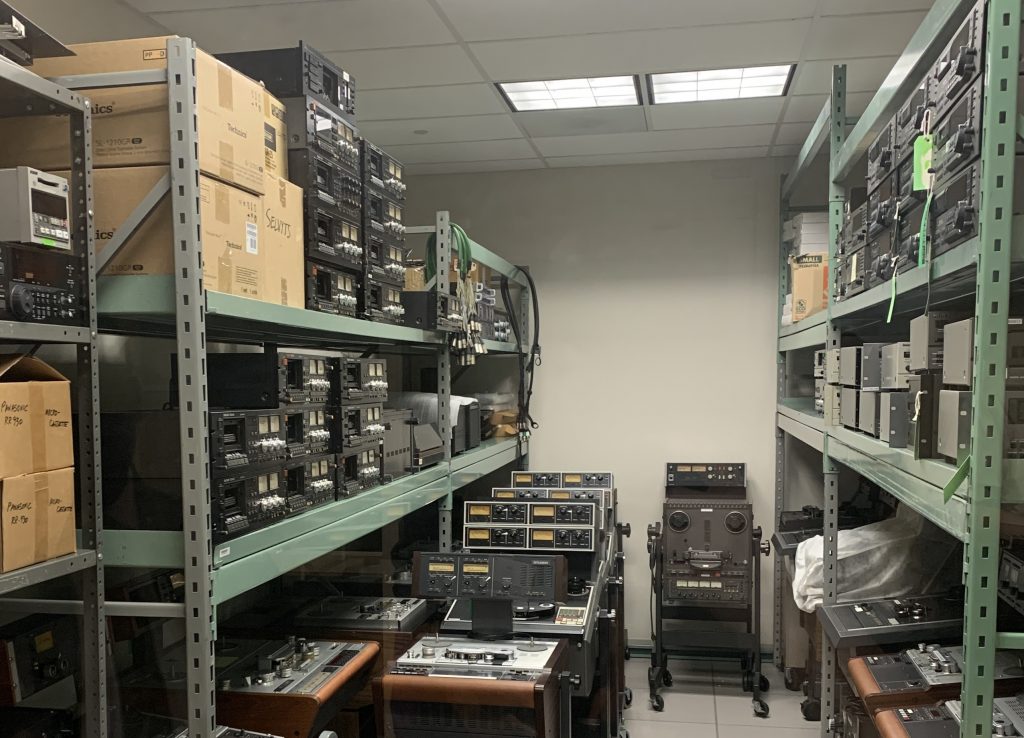Mystery Street Recording at Library of Congress

In June 2023, Mystery Street Owner and Audio Preservation Specialist, Joe Tessone, visited the Library of Congress National Audio-Visual Conservation Center in Culpeper, VA, which was hosting the Audio Engineering Society International Conference on Audio Archiving & Preservation. Tessone received a grant to attend from Columbia College Chicago, where he teaches audio preservation and mastering.
“Touring the Library of Congress Packard Campus has been a dream of mine since 2007, when the facility was first built, which happened to be the same year that I began my career in Audio Preservation at the Old Town School of Folk Music,” said Tessone.

AES Presentations
The AES Conference featured a keynote address by world renown engineer, Leslie Ann-Jones. Her presentation was followed by dozens of other music industry professionals, as well as archivists from numerous non-profit organizations and public institutions from across the globe.
One of the highlights of the event included a demonstration of audio restoration by iZotope Inc.’s principal DSP designer, Alexey Lukin. Mystery Street is a daily user of iZotope’s cutting edge software for audio restoration and mastering. “Watching the designer use his own software opened my eyes to how we can more effectively and efficiently use these great tools in our own Audio Preservation Lab,” Tessone explains, “The software is truly a major step forward for Audio, and it just keeps getting better.”

Another presentation by members of the Recording Academy’s Producers and Engineers Wing was focused on the importance of file naming and folder organization for audio deliverables, particularly in regards to immersive audio. The panel, which included audio giant George Massenburg, representatives from Sony, and others, made a clear case for why audio engineers need to be educated on best practices in our field. This is something that Tessone emphasizes to his audio students at Columbia College. “The best comment of the whole conference,” Massenburg said speaking of Tessone, “was when you stated that a large portion of your student’s grade was file naming and deliverables. More audio educators need to do that.”

Touring the Archives
A part of the Library’s archive tour included a demonstration of their IRENE system; a prototype digital imaging device that takes extremely detailed images of phonograph record grooves, combines them into a single linear image, and converts the image into listenable audio. The revolutionary technology can be used to recover audio from broken and damaged discs, which cannot be played using a standard stylus.

Another very unique area of the tour was the Nitrate Film Vaults. Due to the extreme flammability of nitrate, visitors must leave electronics (and lighters) at the door. The vault is a long hall, nearly freezing cold, with fireproof doors as far as the eye can see, each protecting their room from the others, in case of combustion. Each room contains up to 1000 irreplaceable reels from the likes of Disney and other filmmakers of the nitrate era, as well as a multifaceted sprinkler system, and a “blow out” exhaust that will shoot all of the material out of a vent to the outside world, in case a fire did start in one of the rooms. To top it off, the entire archive is built into the side of a mountain, as an extra precaution.
Meeting and Exceeding Best Practices
Ultimately, the visit to the Library of Congress brought Mystery Street full circle, as the company started business the same year the Audio-Visual Conservation Center opened. Since the beginning, Mystery Street’s Audio Preservation Specialist, Joe Tessone, has collected the same equipment as Library of Congress and has applied the same techniques for audio digitization and restoration. Seeing it all in person proved that Mystery Street’s preservation work meets the same high standards practiced by the largest and most respected audio preservation center in the country.

The “Ready Room” at LoC, full of Studer, Otari, and Tascam playback equipment. The same gear is used at Mystery Street for audio preservation.

